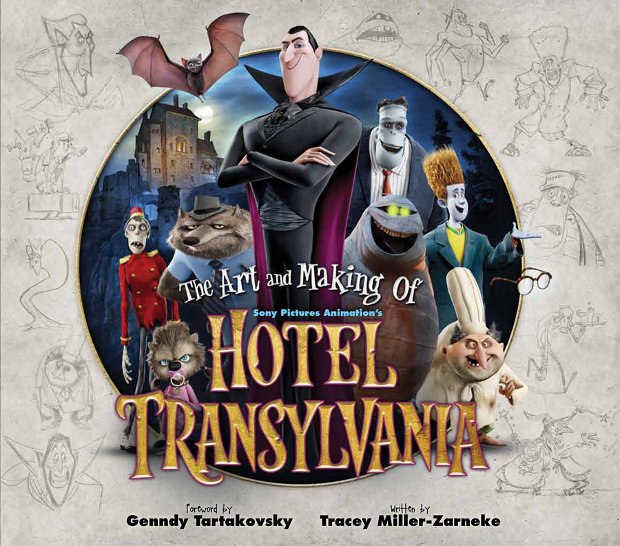This lush new book is a must have for fans and for anyone looking to dig deep into character design progressions.
London, Titan Books, September 2012, hardcover $34.95 (160 pages)
These coffee-table the-making-of art books get more lush and lavish all the time! If the advances in book-publishing technology over the past few years continue, the equivalent books by the end of the decade will probably feature three-dimensional holograms and audio clips.
The Art and Making of Hotel Transylvania is the be-all, tell-all book about Sony Pictures Animation’s computer-graphics and 3-D Hotel Transylvania animated feature, to be released on 28 September. The book is written by Tracey Miller-Zarneke, a voice actress on Disney’s Meet the Robinsons, assistant production manager on The Emperor’s New Groove and Chicken Little, and the author of the making-of art books about Meet the Robinsons, Kung-Fu Panda, Cloudy With a Chance of Meatballs, How to Train Your Dragon, and Kung-Fu Panda 2. The Foreword is by Hotel Transylvania’s Director, Genndy Tartakovsky, and the Introduction is by Bob Osher, the President of Sony Pictures Digital Productions.
Without doing a scientific analysis, I would say that the emphasis of this Art and Making of book is 100% on the Art and 0 % on the Making of. The first 100 pages of this 160 page book are devoted to Character Design. There are ten pages on Dracula alone. Mavis, Dracula’s teenage daughter (she’s 118 years old), gets six pages. Jonathan, the young human backpacker who crashes the castle and Mavis’ birthday party, gets another six pages. Supporting characters get lesser amounts, but there are over a dozen supporting characters from the more prominent to the minor background roles that most moviegoers will barely notice, from Wayne and Wanda Werewolf and Murray the Mummy to the castle’s zombie bellhops, Mr Hydraberg, Steve the green blob, the Day of the Dead mariachi band, the Drop-In Guests (assorted skeletons, floating brains, giant flies, and the like), Quasimodo the chef, a large tentacle named Gustav, and even Glenn-who-is-offstage-in-the-movie-but-if-he-was-shown,-this-is-what-he-would-look-like. The last 60 pages are Production Design; mostly the ancient castle before and after its renovation into a luxury hotel for monsters, with the adjoining cemetery, typical Transylvanian town, and the modern human world beyond.
The additional emphasis on Character Design are what makes this book a must-have item for Hotel Transylvania’s fans. Where most art-&-making-of books only devote a few pages to the main characters, this book shows many preliminary designs for Dracula, Mavis, and Jonathan. Dracula was originally conceived of as a much more typical Old World aristocratic nobleman before the decision to make him a stylized version of his voice actor, Adam Sandler, in a cloak & cape. Jonathan went through several versions as a scruffy teenage human backpacker, including a stereotypical hippie/beatnik, before settling on the more cartoony design that allowed exaggeration into “Johnny Stein” the pseudo-monster. With this emphasis, The Art and Making of Hotel Transylvania has even fewer black-&-white pages than most of these coffee-table art books. There are a few black-&-white preliminary pen-&-ink sketches, but mostly these are lavish full-color digital paintings, each one identified by its artist. Even the storyboard and storybeat art is in full color more than monochromatic.
There is little plot here, but there is not much in the movie. Dracula, wanting to protect his newborn daughter Mavis from the humans who infest the world, turns his Transylvanian castle into a self-contained luxury hotel for monsters. All goes well until Mavis becomes a teenager and wants to see the world outside the hotel. At her 118th birthday party, Jonathan, a young human backpacker, stumbles into the hotel. Dracula tries to disguise him as Johnny Stein, a monster, but he and Mavis meet and fall in love. Or maybe it’s just Jonathan’s rebellion against authority, but he agrees to help Mavis escape from her overprotective father.
No, the reader looking for information on how to make a modern CGI animated feature will find The Art and Making of Hotel Transylvania very lacking in production details. But for sheer gorgeousness with over 400 pieces of art, it stands out among all the other coffee-table animation-art books.
(Needless to say, there is no relation between the movie’s fantasy Transylvania and the real province in Romania. Or between this movie and the vampire romance of the same title, Hotel Transylvania; A Novel of Forbidden Love, by Chelsea Quinn Yarbro; St. Martin’s Press, October 1978; still in print after almost thirty-five years.)
--
Fred Patten has been a fan of animation since the first theatrical rerelease of Pinocchio (1945). He co-founded the first American fan club for Japanese anime in 1977, and was awarded the Comic-Con International's Inkpot Award in 1980 for introducing anime to American fandom. He began writing about anime for Animation World Magazine since its #5, August 1996. A major stroke in 2005 sidelined him for several years, but now he is back. He can be reached at fredpatten@earthlink.net.










